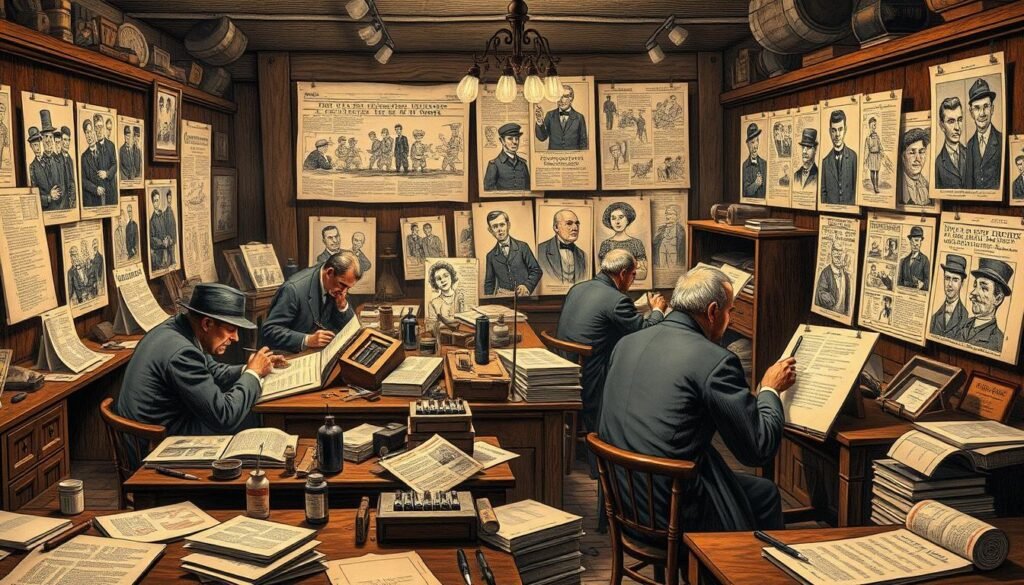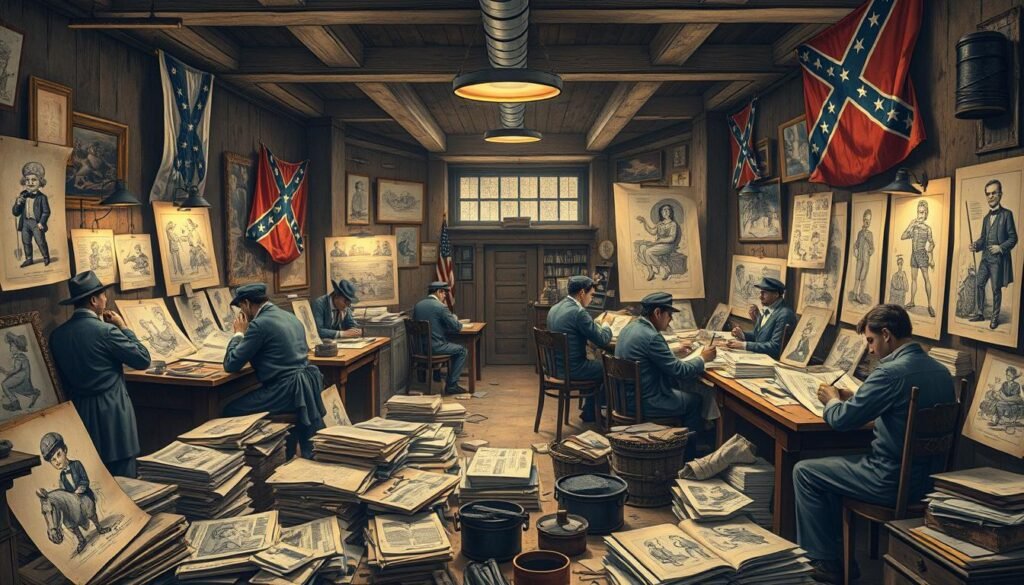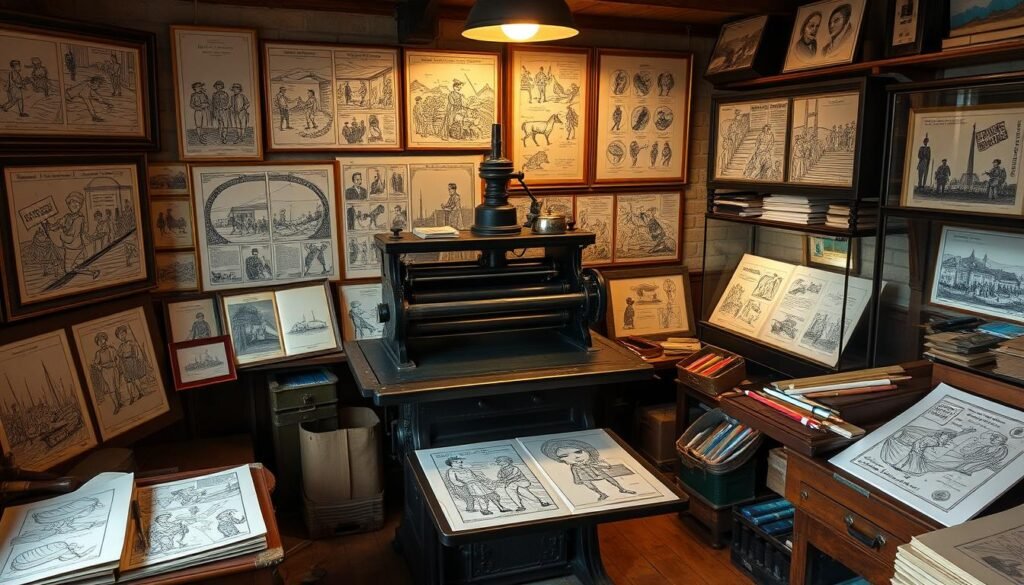The Transition from Sketch to Print in Civil War Cartooning
Over 1,900 sketches by “Special Artists” and soldier-artists are part of the Civil War Drawing Collection. This collection shows the big role of The Transition from Sketch to Print in Civil War Cartooning. It features work by famous artists like Alfred Waud and Thomas Nast.
These artists quickly turned their sketches into engravings for newspapers. This gave the public visual updates on the war. It also brought Civil War cartoons to life.
The time from sketch to print was about three to four weeks. This was fast for then. It helped shape public opinion and explain complex issues simply.
This made The Transition from Sketch to Print in Civil War Cartooning very important in American history.
Key Takeaways
- The Civil War Drawing Collection contains over 1,900 sketches by “Special Artists” and soldier-artists, highlighting the importance of The Transition from Sketch to Print in Civil War Cartooning.
- Notable artists like Alfred Waud and Thomas Nast played a significant role in creating Civil War cartoons that informed the public about the war.
- The transition from sketch to print took approximately three to four weeks, allowing for rapid dissemination of information and updates on the war.
- The collection features contributions from over twenty-five artists, showing the variety of views and styles in Civil War cartooning.
- The Transition from Sketch to Print in Civil War Cartooning was key in making complex issues simple. It helped people understand the war better.
- Civil War cartoons often showed figures like Lincoln and the struggles over freeing slaves. They highlighted the big tensions of the time.
The Dawn of Civil War Era Illustration
The Civil War era marked the beginning of field artists documenting the war. They used early sketching techniques with traditional materials like pencils, ink, and paper. The Sketch to Print transition was key, making their work accessible to more people.
Artists like Alfred Waud faced tough conditions, using whatever they could find. Despite the dangers and limited supplies, they created thousands of sketches. These were later printed in newspapers, giving us a visual history of the war. The Cartooning history of this time highlights the value of their work.
Early Sketching Techniques
Field artists used quick sketches and detailed drawings. These methods helped them capture the battlefield’s chaos and the quieter moments in camp.
Traditional Materials Used
Artists relied on pencils, ink, and paper. These materials were often hard to find, requiring the artists to be creative.
Field Artists and Their Role
Field artists were vital in documenting the Civil War. Their sketches and drawings gave us a visual record of the conflict. The Sketch to Print transition was key, making their work widely available.
Political Climate and Its Influence on Wartime Art
The political climate during the Civil War era greatly affected the art made back then. Many cartoons and illustrations showed the views and tensions of society. Print media in Civil War era was key in shaping public opinion and expressing views on the war and slavery.
John McLenan’s “Contraband of War,” published in Harper’s Weekly on June 29, 1861, is a great example. It shows how print media in Civil War era could send strong messages. The term “contraband” quickly became popular, with people adopting it fast.
- Reflection of societal views and tensions
- Expression of opinions on the war and slavery
- Influence on the type of art produced
In summary, print media in Civil War era was very important. It helped shape public opinion and showed the political climate of the time.
| Artist | Notable Work | Publication Date |
|---|---|---|
| John McLenan | Contraband of War | June 29, 1861 |
The Evolution of Printing Technology in the 1860s
The 1860s were a time of big changes in printing technology. This had a huge effect on how Illustration techniques in Civil War were shared. The steam press, as Ellen Goldner pointed out, made it easier to make prints fast. This meant cartoons could reach more people.
This change was key in moving from sketches to prints. It allowed for making and sharing prints on a large scale.
The Printmaking advancements in 19th century went beyond just presses. New inks and better paper also helped make prints look great. Artists could now make detailed and complex illustrations. These were used to influence public views on the war and other issues.
- Advancements in press machinery, such as the steam press
- Innovations in ink development, allowing for more vibrant and detailed prints
- Improvements in paper quality, enabling the production of higher-quality prints
These changes in printing technology were vital for sharing Illustration techniques in Civil War. They greatly affected how people saw and interacted with prints back then.
| Development | Impact |
|---|---|
| Steam press | Enabled rapid production of prints |
| Ink development | Allowed for more vibrant and detailed prints |
| Paper quality improvements | Enabled production of higher-quality prints |
Notable Civil War Cartoonists and Their Styles
During the Civil War, political cartoons were key in shaping public views. Cartoonists like Thomas Nast and Alfred Waud made big impacts. Nast, for example, introduced symbols like the Republican elephant and the Democratic donkey through his political cartoons during Civil War.
Some notable cartoonists of the time include:
- Thomas Nast: Known for his political cartoons during Civil War and his work at Harper’s Weekly.
- Alfred Waud: Recognized for his detailed sketches of battles.
- Etta Hulme: A cartoonist who began her career in 1954 and was part of the Fort Worth Star-Telegram from 1972.
Their work showed the political climate and shaped how people saw the war and its leaders. These artists used their art to talk about the issues of their time. This made political cartoons during Civil War a strong tool for social commentary.
The Transition from Sketch to Print in Civil War Cartooning
Making editorial cartoons in Civil War era was tough for artists. As more people wanted to see these cartoons, artists had to learn new ways to create them. This change was a big step forward in sharing news through pictures during the Civil War.
Artists faced many hurdles, including:
- Learning to work with new materials and techniques
- Adapting to the time it took for sketches to be converted into prints, which typically took three to four weeks
- Overcoming the limitations of printing technology, which relied on wood engraving techniques to produce detailed images in black and white
Despite these challenges, the shift to print helped spread editorial cartoons in Civil War era far and wide. These cartoons were key in shaping public views and guiding the war’s direction. Wood engraving made it possible to print many copies, reaching more people and making complex ideas easier to understand.
The table below shows some interesting facts about the Civil War Drawing Collection:
| Category | Description | Number |
|---|---|---|
| Sketches | Total number of sketches in the collection | Over 1,900 |
| Artists | Number of artists featured in the collection | Over 25 |
| Publications | Major publications that commissioned sketches | Harper’s Weekly, Frank Leslie’s Illustrated Newspaper |
Distribution Networks and Publishing Houses
The Civil War era saw cartoons spread through networks and publishing houses. Harper’s Weekly was key in getting these cartoons to many people. They used different ways to make sure prints got to both cities and countryside.
Print media was key in shaping public views and sharing news during the Civil War. Publishing houses led this effort. They made and spread cartoons, maps, and other materials to everyone.
Major Publishers
- Harper’s Weekly
- Prang and Company
- H. H. Lloyd
These publishers used mail subscriptions and newsstands to reach many. Print media in the Civil War era was a strong tool for changing public views and telling the war story.
The role of publishing houses in sharing cartoons was huge. They were essential in making sure these materials got to the people. This helped the war effort and shaped public opinion.
| Publisher | Notable Works |
|---|---|
| Harper’s Weekly | Cartoons, maps, and illustrated news |
| Prang and Company | War Telegram Marking Map |
| H. H. Lloyd | Maps of the Southern States and the Mississippi River |
Impact of Civil War Cartoons on Public Opinion
During the Civil War, political cartoons were key in shaping public views. Idris A. Young says they deeply influenced how people saw the war and its leaders. These cartoons offered a visual take on events, shaping public understanding and views of the conflict.
Cartoonists like Thomas Nast were key in this effort. His work in publications like Harper’s Weekly helped mold public opinion on big issues. Cartoons like “Hero of Vicksburg” and “Unconditional Surrender” made Ulysses S. Grant seem like a national hero. This boosted morale during the war.
- Influencing public perception of the war and its leaders
- Shaping national issues and electoral outcomes
- Contributing to the downfall of corrupt politicians, such as Boss Tweed
In summary, political cartoons during Civil War were vital in shaping public opinion. Their influence is seen today, with many symbols and themes from that time remaining in American politics.
Preservation Techniques and Archive Methods
Cartooning history is rich and diverse. Many historical cartoons and sketches are saved for the future. Modern methods, like digital preservation, are key to keeping these artifacts safe.
Archives are important for saving historic materials. They make these items available to researchers and the public. Archives like college, corporate, and government ones focus on specific areas.
Original Sketch Conservation
Keeping original sketches safe is critical for cartooning history. Techniques like acid-free paper and climate-controlled storage are used. Handling them with gloves also helps prevent damage.
Print Storage Solutions
Prints are stored in solutions like archival boxes and folders. These protect the prints from damage, dust, and moisture. They keep the prints safe for a long time.
Digital Preservation
Digital preservation scans and digitizes historical cartoons and sketches. This makes them available online. It helps keep the original artifacts safe while making them easier to access.
Using these preservation techniques and archive methods helps save cartooning history. It gives future generations a glimpse into the past. It also inspires new artists and researchers.
Artistic Innovation During Wartime
The Civil War era was a time of great change in illustration techniques. Artists like Alfred Waud and Thomas Nast introduced new styles. Their work was seen in Harper’s Weekly, which had up to 200,000 readers between 1861 and 1865.
Some major changes in illustration techniques in Civil War art include:
- Shift from heroic to realistic depictions of war
- Focus on the common soldier instead of military officers
- Emphasis on the psychological effects and grim realities of war
About 30 artist-reporters created around 6,000 images for New York City’s three illustrated weekly newspapers. This showed a change in what people wanted to see in war stories. They wanted real images, not just romantic tales.
The illustration techniques in Civil War art paved the way for photojournalism. It changed how people saw war through more realistic pictures. The Civil War was the first war to be widely shown through illustrations, thanks to new technology in the 1850s.
The Role of Newspapers in Cartoon Distribution
Newspapers were key in sharing cartoons during the Civil War era. Print media was the main way to spread them. Big names like Harper’s Weekly led in publishing cartoons that shaped public views and the war’s visual story.
The relationship between cartoonists, publishers, and readers was complex. Publishers chose which cartoons to print, affecting what people saw and thought about the war.
Major Publications
- Harper’s Weekly
- The New York Times
- The Washington Post
These papers, along with others, spread cartoons far and wide. This made print media in Civil War era essential for sharing news and views. Cartoons in newspapers helped spread information fast, shaping public opinion and the war’s path.
Newspapers had a big impact on sharing cartoons. Cartoonists like Thomas Nast played a big role in the war effort through their art. The use of print media in the Civil War era was a major milestone in cartooning’s growth as a tool for social commentary and communication.
| Publication | Cartoonist | Notable Work |
|---|---|---|
| Harper’s Weekly | Thomas Nast | Cartoon on September 3, 1871 |
| The Washington Post | Herbert Block | Cartoon on June 17, 1951 |
Cultural Impact and Historical Significance
Civil War cartoons have had a big impact on American culture and cartooning history. They showed the tensions and issues of their time. This made them a key part of the United States’ cultural and historical story.
Some key points about the cultural impact of Civil War cartoons are:
- They have influenced later cartooning and comic art, becoming a big part of American culture.
- They helped shape public opinion and critical thinking among viewers.
- They used satire and caricature to reflect on social and political issues.
The importance of Civil War cartoons is clear in their lasting impact on American art and culture. As cartooning history keeps growing, these early cartoons stay important. They help us understand the medium and its role in public discussions.
Conclusion: Legacy of Civil War Cartooning in American Art History
The legacy of Civil War cartooning shows how art can change public opinion and shape history. These cartoons, moving from sketches to prints, documented the war’s turmoil. They also influenced how people saw the war and its effects.
Artists used new techniques, and famous cartoonists emerged. This movement’s lasting impact has made it a key part of American art history.
Looking into Civil War cartoons teaches us about art in conflict times and how printing changed. It shows how pictures can tell us about history. Today, these cartoons inspire new artists and spark debates about history.
As we reflect on the Civil War’s legacy, these cartoons offer a unique view. They help us understand the war’s complex impact on America.
FAQ
What was the significance of the transition from sketch to print in Civil War cartooning?
What role did field artists play in documenting the Civil War?
How did the political climate influence the art produced during the Civil War?
What advancements in printing technology contributed to the transition from sketch to print?
Who were some of the notable cartoonists that emerged during the Civil War?
What challenges did artists face in the transition from sketch to print?
How were cartoons distributed during the Civil War?
What was the impact of Civil War cartoons on public opinion?
Why is the preservation of Civil War cartoons and sketches important?
How did the Civil War period influence artistic innovation in illustration techniques?
What was the role of newspapers in the distribution of cartoons during the Civil War?
What is the cultural impact and historical significance of Civil War cartoons?
Source Links
- Research Guides: Documentary Drawings in the Library of Congress, 1776-1970: Civil War Drawings
- Microsoft Word – 177_Idris Young
- A History Quivering with Life: Civil War Drawings | Picture This
- The Poignant Tale Behind a Celebrated Civil War Sketch
- Civil War era drawings from the Becker collection”
- Cartooning Contraband: Humor in Harper’s Weekly – Emerging Civil War
- Book Review – Drawing Fire: The Editorial Cartoons of Bill Mauldin.
- Art in a Time of War
- The Art of Suffrage: Cartoons Reflect America’s Struggle for Equal Voting Rights | Constitutional Accountability Center
- Drawing the Battle Lines
- Political Illustrations – Cartoon America | Exhibitions
- The Comic News, Lincoln, and the Civil War
- Thomas Nast
- Alfred R. Waud: Sketching as the Bloody Battle Raged
- Commercial Mapping | History of Mapping the Civil War | Articles and Essays | Civil War Maps | Digital Collections | Library of Congress
- History of American newspapers
- Political Cartoons (Published 2013)
- Editorial Cartooning, Then and Now
- Political Cartoons – Bailey Dowlin Art
- Microsoft Word – DrawingfromtheArchives_book_typescript_final.docx
- Anglais
- Embedded with Union troops, Winslow Homer documented the Civil War in art
- Thomas Nast: An Innovative Political Cartoonist
- Documenting History: The Story of the Civil War’s Forgotten Sketch Artists
- Brief History of the Editorial Cartoon · Epidemics, Economics, and Elections · RIT Archives Digital Exhibits
- Creating Cartoons: Art and Controversy | Timeless
- Accounting for Transformative Moments in the History of the Political Cartoon
- Women as Objects in Civil War Art
- The Art of the Great Depression – The Metropolitan Museum of Art
- The New View Of Reconstruction
- Smarthistory – Abraham Lincoln and northern memory
- William H. Johnson
























